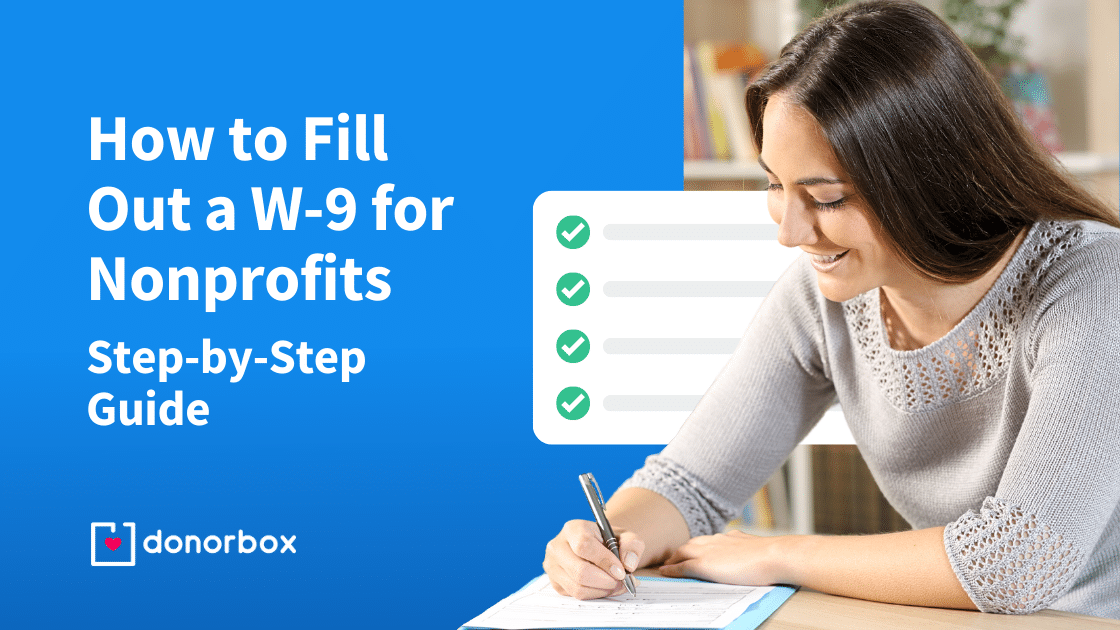When you’re running a nonprofit, it can feel daunting to think about filling out yet another form. Internal Revenue Service forms are notorious for being confusing and overly complicated. Chances are you’d rather focus your energy on something else—like your organization’s mission.
But fear not! IRS Form W-9 is actually a pretty simple form whether you’re requesting it from someone else or you have to fill one out yourself.
Read on for a step-by-step guide to make filling out a Form W-9 a breeze.
What is a Form W-9 for Nonprofits?
Your first step is to make sure you understand what the form is used for.
IRS Form W-9 is used when a business or entity needs to obtain the Tax Identification Number (TIN) from a contractor or business they have conducted business with. In other words, it is a request for taxpayer identification.
Typically, the W-9 is only needed if the business has paid a contractor over $600 for the course of the year. Neither the business that requested the W-9 nor the contractor will file the Form W-9 with the IRS – it is purely to share the information required for other forms and filings.
Along with a contractor’s TIN, the W-9 Form also collects information on their backup withholding status. In most cases, the contractor is not subject to backup withholding and is therefore responsible for paying taxes on that income.
The information collected on Form W-9 is then used by the business or nonprofit to file the Form 1099-MISC, which documents the total amount of money paid to the contractor.
What does this mean for nonprofits? As you know, you may be tax-exempt but that doesn’t mean you don’t have to report anything to the IRS. Your biggest annual reporting happens with tax form Form 990. However, there are two cases where you’ll have to worry about filling out or requesting the W-9.
When Do You Need to Fill Out a W-9?
Here are two instances where you might need to deal with Form W-9:
- You get paid by someone else. Let’s say you run a 501(c)(5) agricultural nonprofit, and you provide some paid consulting work to a different farming cooperative. That cooperative will request a W-9 from your organization. Your organization has to fill out the form and return it in a timely manner so the farming cooperative can file the 1099-MISC form documenting that paid work.
- You pay someone else. Your organization partners with a local artist to design and paint a mural around the city promoting your recent campaign. After you’ve paid the artist anything more than $600, you should request a W-9 from them. This will give you their TIN, address, and name so you can successfully document the income paid on a Form 1099-MISC. It will also clarify if they are subject to backup withholding. Be sure to check the Instructions for Requester of Form W-9 to ensure you’re within your rights to ask someone for their TIN.
How to Fill Out the Form W-9 for Nonprofits
Internal Revenue Service forms can be a headache. Luckily, the W-9 Form is one of the more straightforward forms.
Here’s how you can fill out the Form W-9 for Nonprofits:
Step 1 – Write your corporation name
This refers to your official nonprofit corporation name as listed on your articles of incorporation. Be sure to write it exactly as it appears in your articles of incorporation and in your other IRS filings. You’ll share your more common name in the next step.
Step 2 – Enter your business name
Sometimes referred to as your assumed name or fictitious name, this should be the name your organization operates under. Only enter this if it’s different from your corporation name.
Pro tip: This is the name the public sees most often, which is usually only slightly different from the official name on your articles of incorporation (i.e., your official name includes “Inc.” and your business name does not).
Step 3 – Know your entity type
Your nonprofit is a corporation, so you should check the “C Corporation” box on your W-9. You could also check “other” and type “nonprofit corporation” in the provided line.
Step 4 – Your exempt payee code
Nonprofit organizations exempt from tax under IRS code 501(a) are likewise exempt from backup withholding. Organizations that fall under this exemption must enter one as described in the W-9 instructions. Other federal tax classifications may not be exempt from backup withholding.
Step 5 – Give your street address
Enter your organization’s mailing address in address lines 1 and 2.
Step 6 – Give your city, state, and zip code
The next fields are city, state, and zip code. Be sure these are for your organization’s registered mailing address, which is usually the location of your organization or your organization’s registered agent.
Step 7 – List account numbers
This space is for account numbers you wish to share with your W-9 requester. You don’t have to fill this out, but it is a secure way to share this information.
Step 8 – Taxpayer Identification Number (TIN)
Mark your Employer Identification Number (EIN) issued by the IRS here.
Need to apply for an EIN? You first need to file Form SS-4 as soon as possible. Once you’ve applied (or if you plan on applying right away), you can write “Applied For” in the space for the TIN, sign, and date the form as you normally would, and give it to the requester. Usually, this means you have 60 days to provide your correct Taxpayer Identification Number to whomever requested a W-9 from you. But you should double-check with your own tax advisors to be sure your payment type is eligible for this extension.
Step 9 – Certify your information
This section is also pretty straightforward, though you should check the instructions included in the form to be sure your unique situation doesn’t require any further acknowledgment. This section simply asks you to certify that the information you provided is true to the best of your knowledge. Sign on the line and mark the day’s date.
w-9 Forms can also be signed and submitted electronically, so no need to worry about printing and signing.
And that’s it! Once it’s filled out, you can move on to the next step.

How to Submit a Form W-9
Submission depends on which side of the W-9 Form you’re on: requester or requestee. Here’s what to do in either case.
- Someone asked your organization to complete a W-9. Great! All you have to do is fill the form out and get it back to them ASAP. It’s a good business practice to take no more than around a week to get the form back to them once you receive the request. Since it’s such a simple form, you shouldn’t run into any major snags unless you have to apply for an EIN.
- Your organization asked someone else to fill out a W-9. When you request the form, give clear instructions for how you’d like to receive the signed form. You can ask them to fax it to you, send a copy via email, or complete the form via an online document service.
Once you have the signed form, you can look into completing Form 1099-MISC and returning it to the person or organization in question. Usually, if your organization has paid at least $600 throughout one year to a non-employee for services, parts, and materials needed for your organization’s business, you must furnish a Form 1099-MISC to that person by January 31 of the following year.
Conclusion
Although filling out IRS forms can sometimes feel like a nightmare, the Form W-9 is luckily pretty simple for nonprofit organizations. This leaves you more time to focus on the work that really matters and less time squinting at the small type on a form.
The w-9 Form requests information like name, Taxpayer Identification Number (TIN), address, and whether someone is subject to backup withholding. It’s an important form to help with tax time, especially if your nonprofit has used contractors or done any contracting work.
The most important step? Know that you got this. With some careful work, you can fill out the Form W-9 easily and correctly. The business or individual you’re working with will thank you for a prompt response!
Looking for more ways for running your nonprofit easier? Check out the other resources on our Nonprofit Blog. We also have dedicated articles for starting a nonprofit in different states in the US, including Texas, Minnesota, Oregon, Arizona, Illinois, and more. Plus, our Library is packed with free downloads to make every step of the nonprofit process easier.
Frequently Asked Questions [FAQs]
1. What is a W-9 Form?
The Internal Revenue Service provides the W-9 Form for businesses who need a secure and clear way to collect information from their contractors. They then use that information to fill out a Form 1099-MISC for any contractors and freelancers that have been paid at least $600 for their work over the course of the tax year.
This form helps contractors file their taxes correctly. So the W-9 Form is the key to making tax season run smoothly for all involved!
2. What information do you need for a W-9 Form?
In order to fill out a W-9, you’ll need the following information:
- Your name (or your corporation’s name, as listed on your articles of incorporation)
- Your business name (the name you use publicly)
- Your entity type
- If you’re subject to backup withholding, you’ll need –
- Your exempt payee code (if any)
- Your exemption from FATCA reporting code (if any)
- Your mailing address
- Your account numbers (optional)
- Your Taxpayer Identification Number – either your Social Security Number (SSN) or Employer Identification Number (EIN)
You’ll then need to sign to certify that all provided information is correct. Once you provide your identification number and certification, you simply need to return the form to the requester.
3. What is a Tax Payer Identification Number?
A Taxpayer Identification Number (TIN) is a unique number that identifies individuals and businesses in the eyes of the Internal Revenue Service. There are two main types of TINs you’ll use on your W-9 Form –
- For individuals – Social Security Number (SSN)
- For businesses and nonprofits – Employer Identification Number (EIN)
Check out our compact guide to EINs for more information.
4. What tax forms do nonprofits need?
Nonprofits primarily report their annual income on Form 990, a comprehensive form that includes an organization’s budget, expenses, salaries for their highest-paid individuals, and contributed income. Form 990 is publicly available so potential donors can see how nonprofits operate. This is a great way for nonprofits to maintain transparency and maintain their 501(c)(3) status.
Otherwise, nonprofits use W-9 Forms for any contractors or freelancers that provide goods or services. They might also fill out W-9 Forms for any work they do for other businesses or individuals.
5. Why do nonprofits need a W-9 Form?
Nonprofits need a W-9 for two reasons –
- They paid a contractor $600 or more over the course of the tax year for goods or services. In this case, the nonprofit requests a W-9 Form from their contractor to get the information necessary to provide them with a Form 1099-MISC. This form helps the contractor file their own taxes.
- They provided goods or services worth $600 or more to another individual or business. In this case, the business or individual that benefitted from these goods or services requests a W-9 Form from the nonprofit to get the necessary information.
Either way, the purpose of the W-9 is to accurately and securely share important identifying information for tax requirements.





